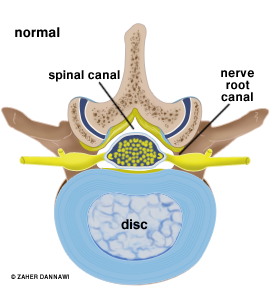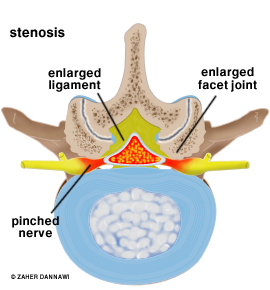What Is Spinal Stenosis?
Below the lumbar spine lies the sacrum, which on either side joins the pelvis through the sacro-iliac joints. Below the sacrum is the coccyx. Looking at the spine from the back it appears to be straight. From the side there are several curves, in the cervical spine the neck curves backwards (lordosis), in the thoracic spine it curves forwards (kyphosis). Again in the lumbar spine it curves backwards(lordosis). Spinal stenosis is a term used to describe a narrowing of the spinal canal.
This narrowing may occur throughout the whole spine, but mainly within the more mobile areas of the spine, either within the lumbar spine (lower back) or the cervical spine (neck).
The narrowing may cause symptoms due pressure on the spinal cord, or pressure on the nerve roots, which is often seen within the lumbar spinal canal.
Stenosis within the lumbar spine often occurs as a result of degenerative changes within the spine, known as spondylosis. These are part of the natural aging process within the spine, but in some people the degenerative changes within the facet joints at the back of the spine and the intervertebral discs at the front cause narrowing of the spinal canal, with subsequent pressure on the spinal nerves.
If this occurs in the main central spinal canal it is termed central stenosis and if the narrowing affects the smaller side tunnels with the spine it is called foraminal stenosis or ‘lateral recess stenosis’. Patients may experience leg pain, in one or both legs, as well as a feeling of heaviness, weakness or numbness within the legs.


Typically these symptoms occur, or are made worse by walking, with patients experiencing increased pain and heaviness within the legs along with pins and needles, numbness, weakness and unsteadiness. The tunnels in the spine are smaller when standing, but get larger on sitting with the spine bent. The nerves within the spine are both compressed by the constriction and also their blood supply is temporarily reduced by the compression. Consequently symptoms may be relieved by resting, leaning forward or sitting down.
I also have back pain, is the treatment the same?
The leg symptoms may be associated with back pain. It is important to decide which is the major symptom, back pain or leg pain, as the treatment options may be different depending on the predominant problem.
What else could be causing my leg pain?
Other causes of the leg symptoms may be pain from the hip or from narrowing of the arteries within the legs. Narrowing of the leg arteries may cause pain on walking termed, vascular claudication. These symptoms may be very similar to the symptoms of spinal stenosis (spinal claudication), and tests on the blood supply to the legs may be needed to determine which is causing the symptoms.
Other causes include diabetes or vitamin B12 deficiency, both of which can be diagnosed with simple blood tests.
Will I get better without treatment?
The course of the problem has some uncertainty, but a general rule can by applied that 70% of patients will stay the same, 15% may improve and 15% could potentially deteriorate with time.
What treatments are available?
Treatment options fall broadly into three categories.
Conservative Management
Improving spinal mobility, strength and overall fitness may improve symptoms to a satisfactory level. Static cycling is extremely good exercise. Patients generally do not experience as much pain as when they walk because the spine is in the flexed or bent position, therefore increasing the space available for the nerves. It is important to note that the presence of pain does not indicate that damage is being done to the spine. Simple pain control, using over the counter medication such as Paracetamol or anti-inflammmatories, such as Ibuprofen, are extremely helpful. Nerve pain modifying drugs such as Amitriptyline, or Gabapentin may also be useful in controlling the pain.
Spinal Injections
Spinal injections are extremely useful in some patients to help relieve the leg or back pain symptoms associated with spinal stenosis. They may also be useful to assist in localising the area within the spine, which is causing the symptoms prior to planning surgery. They have the advantage of being performed under sedation or local anaesthetic and although there are potential risks and side effects, these are extremely rare. They can also be repeated if required.
Epidurals are an injection into the spinal canal that will treat the whole area of the lumbar spine. They seem to be more helpful for leg pain but may be of some benefit for back pain.
Nerve root blocks, root canal injections, or transforaminal epidurals are some of the names given to injections around a nerve. They can be very helpful for leg pain, particularly symptoms in just one leg. They are also helpful with localising the area of the spine, which is causing the problem, prior to planning surgery.
Often by blocking the nerve pain with anaesthetic the symptoms will improve permanently or give a period of prolonged pain relief. It is estimated that 60% of patients will have significant relief of symptoms.
Surgery
If symptoms continue to be troublesome despite conservative measures or if symptoms get worse then surgery may be considered. This will also depend upon your general health and fitness.
The pressure can be relieved directly by removing the bone and soft tissue, which is pressing on the nerves, this is known as a spinal decompression. Sometimes, a spinal fusion may be added to the decompression if the patient has back pain/ instability or degenerative scoliosis.
Alternatively, the pressure can be relieved by indirect means whereby a device is placed between the spinous processes at the back of the spine creating more space for the nerves.
